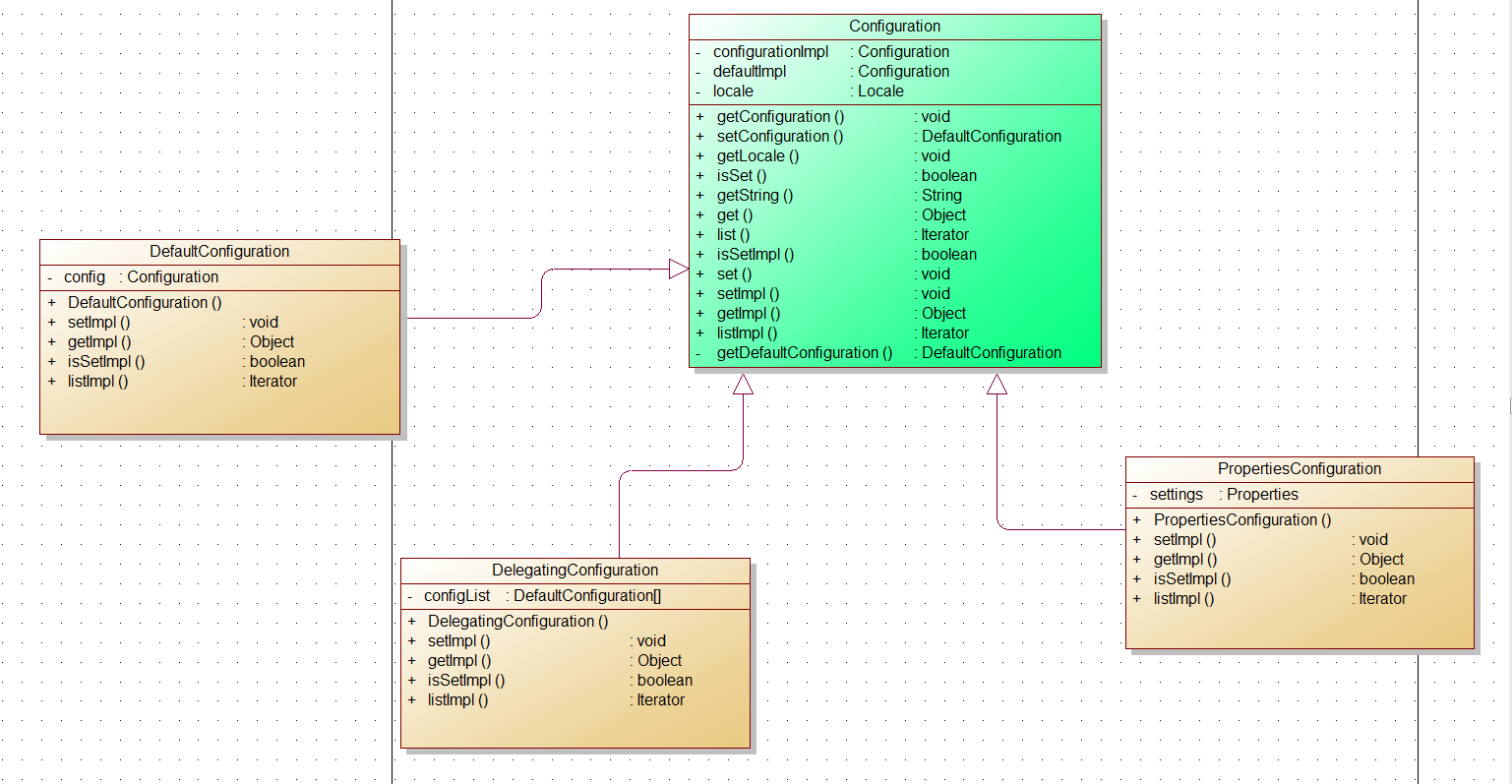Webwork做为经典的Web MVC 框架,个人觉得源码中配置文件这部分代码的实现十分考究。
支持自定义自己的配置文件、自定义配置文件读取类、自定义国际化支持。
可以作为参考,单独引入到其他项目中,下面是Configuration相关类的继承关系:

1. Configuration
- Configuration 作为 webwork 配置文件的核心类,起到了配置信息读取的门户,默认实现类中间引入了代理类 DelegatingConfiguration 与底层的具体实现读取的 PropertiesConfiguration 完全解耦。在项目中使用时,只需要引入 Configuration 类,如下代码即可获取配置信息;
Configuration.getString("webwork.locale")
- getString 方法会调用 Configuration 自身的get 方法,get 方法中调用 getConfiguration 方法:
1 public static String getString(String name) throws IllegalArgumentException { 2 String val = get(name).toString(); 3 return val; 4 }
1 public static Object get(String name) throws IllegalArgumentException { 2 Object val = getConfiguration().getImpl(name); 3 return val; 4 } 5 6 public static Configuration getConfiguration() { 7 return configurationImpl == null ? getDefaultConfiguration() : configurationImpl; 8 }
- Configuration 中定义的两个静态变量defaultImpl 和configurationImpl,还有 一个setConfiguration方法用来设置configurationImpl;
- defaultImpl 是 WebWork 的默认实现类实例的引用,在每一次读取配置文件时,都会去判断是否在 webwork.properties 是否配置了 webwork.configuration 参数(其实框架是无法实现热读配置文件的,下面会说到,每次判断只是确定读取配置信息,使用的框架默认类还是用户自定义类);
- 如果设置了在调用 getDefaultConfiguration() 获得自定义读取类引用 configurationImpl,否则返回 WebWork 自己的 Configuration 实现。
(这里要说一下,随意变动上线系统的配置文件,你会悲剧的,修改前记得问清楚)
1 private static Configuration getDefaultConfiguration() { 2 if (defaultImpl == null) { 3 defaultImpl = new DefaultConfiguration(); 4 try { 5 String className = getString("webwork.configuration"); 6 if (!className.equals(defaultImpl.getClass().getName())) { 7 try { 8 defaultImpl = (Configuration) ObjectFactory.getObjectFactory().buildBean(Thread.currentThread().getContextClassLoader().loadClass(className)); 9 } catch (Exception e) { 10 log.error("Could not instantiate configuration", e); 11 } 12 } 13 return defaultImpl; 14 } catch (IllegalArgumentException localIllegalArgumentException) { 15 } 16 } 17 return defaultImpl; 18 }
- 第一次调用 getDefaultConfiguration() 方法时,默认实现 defaultImpl 是空,则进入创建一 个 WebWork 自己的实现 DefaultConfiguration 的实例,并通过这个实例读取 WebWork 配置信息。
- 上面代码第5行有个特殊的地方,和下面的 DelegatingConfiguration中的很相似,下面一起说。
2. DefaultConfiguration

1 public DefaultConfiguration() { 2 ArrayList list = new ArrayList(); 3 try { 4 list.add(new PropertiesConfiguration("webwork")); 5 } catch (Exception e) { 6 this.log.warn("Could not find webwork.properties"); 7 } 8 try { 9 list.add(new PropertiesConfiguration("com/opensymphony/webwork/default")); 10 } catch (Exception e) { 11 this.log.error("Could not find com/opensymphony/webwork/default.properties", e); 12 } 13 Configuration[] configList = new Configuration[list.size()]; 14 this.config = new DelegatingConfiguration((Configuration[]) list.toArray(configList)); 15 try { 16 StringTokenizer configFiles = new StringTokenizer((String) this.config.getImpl("webwork.custom.properties"), ","); 17 while (configFiles.hasMoreTokens()) { 18 String name = configFiles.nextToken(); 19 try { 20 list.add(new PropertiesConfiguration(name)); 21 } catch (Exception e) { 22 this.log.error("Could not find " + name + ".properties. Skipping"); 23 } 24 } 25 configList = new Configuration[list.size()]; 26 this.config = new DelegatingConfiguration((Configuration[]) list.toArray(configList)); 27 } catch (IllegalArgumentException localIllegalArgumentException) { 28 } 29 try { 30 StringTokenizer bundleFiles = new StringTokenizer((String) this.config.getImpl("webwork.custom.i18n.resources"), ","); 31 while (bundleFiles.hasMoreTokens()) { 32 String name = bundleFiles.nextToken(); 33 try { 34 this.log.info("Loading global messages from " + name); 35 LocalizedTextUtil.addDefaultResourceBundle(name); 36 } catch (Exception e) { 37 this.log.error("Could not find " + name + ".properties. Skipping"); 38 } 39 } 40 } catch (IllegalArgumentException localIllegalArgumentException1) { 41 } 42 }
- DefaultConfiguration 并没有直接取读取properties文件,而是通过 PropertiesConfiguration 来实现properties文件的读取;
- PropertiesConfiguration 也同样是 Configuration 的子类,通过java.util.Properties 来解析properties文件,并 赋予自身Properties 实例settings,并覆盖了父类的setImpl、getImpl、isSetImpl、 listImpl 四个方法;
- DefaultConfiguration 通 过 PropertiesConfiguration 首 先 加 载 的 是 webwork.properties,之后又加载了default.properties;
(这里需要说一下,default.properties 是webwork 框架自身的配置文件,封装在 jar 中,假如你在项目的 web.properties 中定义了与 default.properties 相同的参数,看上面程序配置文件的加载顺序,框架先加载你的配置文件,然后加载默认配置文件,你会发现你的参数是不会起作用的,如果你想让你的参数覆盖框架中的,这里你需要自定义配置文件,并且在 项目 webwork.properties 中配置 webwork.custom.properties 参数)
- 将 PropertiesConfiguration 实例放入List中,然后创建一个和 List一样大的Configuration[]数组,并把List 转型为 Configuration[]赋予 实例化 DelegatingConfiguration;
- 加载完两个properties 文件,并创建了DelegatingConfiguration 实例之后, DefaultConfiguration开始在这两个属性文件中查找 webwork.custom.properties,文件名之间用“,”隔开。找到配置后,分割文件名并分别创建PropertiesConfiguration 实例,加入List,加载完所有配置文 件后重新创建DelegatingConfiguration 实例。
- 加载完所有的WebWork 属性文件后, 查找属性文件中指定的国际化资源文件(文件名同样用“,”隔开),如果有,则加载到 LocalizedTextUtil 中,供以后使用。
(毕竟是好多年前编写的源码,这里面的 StringTokenizer 出于兼容性的原因已经被遗留(虽然在新代码中并不鼓励使用它)。API 中建议所有寻求此功能的人使用 String 的 split 方法或 java.util.regex 包)
3. DelegatingConfiguration
- DelegatingConfiguration 也同样是 Configuration 的子类,内部保存了一个 Configuration[]数组configList,并覆 盖了父类的setImpl、getImpl、isSetImpl、listImpl 四个方法,实现对configList 的操作;
- 如果用户没有指定自己的 Configuration 实现,则 Configuration.getString 最终调用的是 DelegatingConfiguration 的 getImpl;
- 在 DelegatingConfiguration 的setImpl 方法实现中,有一个特别的地方,其实也就是上面 Configuration提到的f,底层的实现:
1 public void setImpl(String name, Object value) throws IllegalArgumentException, UnsupportedOperationException { 2 IllegalArgumentException e = null; 3 for (int i = 0; i < this.configList.length; i++) { 4 try { 5 this.configList[i].getImpl(name); 6 7 this.configList[i].setImpl(name, value); 8 9 return; 10 } catch (IllegalArgumentException ex) { 11 e = ex; 12 } 13 } 14 throw e; 15 }
WebWork不支持动态的增加属性配置,但允许修改已配置的属性, configList[i].getImpl(name); 调用的是 PropertiesConfiguration 的 getImpl 方法,实现如下:
1 public Object getImpl(String aName) throws IllegalArgumentException { 2 Object setting = this.settings.get(aName); 3 if (setting == null) { 4 throw new IllegalArgumentException("No such setting:" + aName); 5 } 6 return setting; 7 }
PropertiesConfiguration 会在settings 里去找name,如果找到就返回配置信息,在 DelegatingConfiguration 的setImpl 方法中通过configList[i].setImpl(name, value)修改该属性的配置,否则抛IllegalArgumentException 异常,该异常在 DelegatingConfiguration 的 getImpl 方法中截 获 ,继续往被调用函数抛。 此时则不会执行 configList[i].setImpl(name, value);从而保证了只有配置过了的属性可以被修改,在服务运行的过程中不会有新增的属性,所有的属性都由 Web 服务第一次启动的时候加载。
4. webwork[三][四]小结
以上分析我们可以看见,Web 服务启动的时候,ServletDispatcher 通过 DefaultConfiguration 先 加 载 webwork.properties 和 default.properties , 并 查 找 webwork.properties中webwork.custom.properties 配置的其他属性文件加载。加载完毕 后再通过属性中配置的 webwork.custom.i18n.resources 加载国际化资源文件供以后 使用。之后再查找 webwork.configuration 属性看是否用户指定了自己的 Configuration 实现,如果有就用用户自己的Configuration 实现,否则返回WebWork 自己的实现(DelegatingConfiguration)。大部分情况下,使用 WebWork 自己的实现 已经足够,用户不需要自己去实现一个 Configuration,除非你想加载XML等格式的配 置文件。
